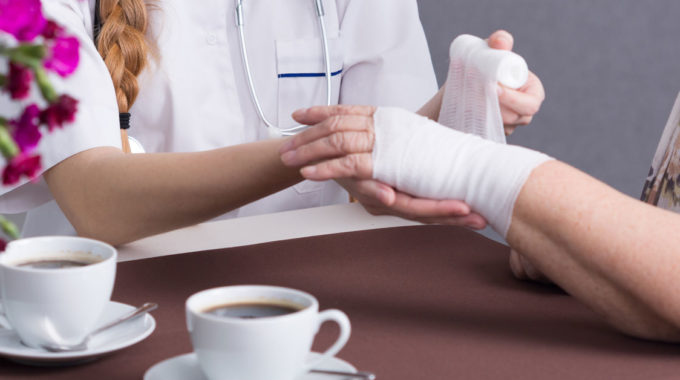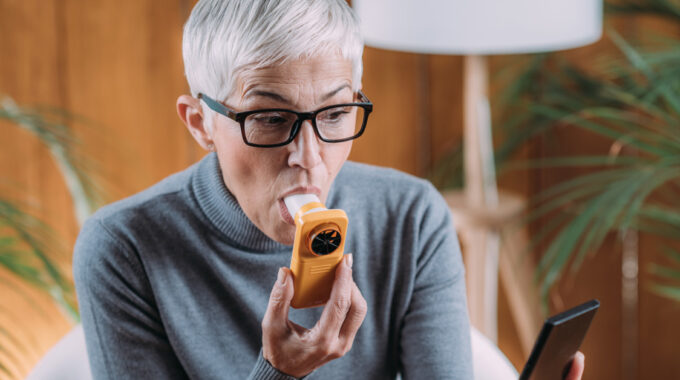
Take Charge of Non-Healing Sores and Wounds
What is Considered a Wound?
In healthcare, most breaks in the skin can be referred to as a wound. Obviously, cutting yourself with a tool is a wound. People often think of wounds as trauma from an accident, but this is only a subset of the lesions that are wounds. It may be less common knowledge that surgical incisions and pressure sores are also considered wounds. A pressure sore is a break in the skin caused by prolonged sitting or lying. Diabetic foot ulcers and venous leg ulcers are also wounds requiring wound care.
What is a Non-Healing Wound?
Ideally, wounds should be well into healing in four weeks.5 Wounds taking longer than that can be considered non-healing. These wounds should be examined by a doctor.
How Prevalent are Non-Healing Wounds for Seniors Living at Home?
The extent of the chronic wound burden is largely unknown. Researchers are reluctant to definitively quantify it due to underreporting in clinical settings, unclear definitions, and inaccurate diagnostic coding.1 We do know that the prevalence increases with age. It is five to seven times higher among people age 80+, compared to people age 65 to 70.2,3
How Serious are Non-Healing Wounds?
Every day in the U.S., 230 Americans with diabetes suffer an amputation of the leg or foot.4 These situations often start with non-healing wounds, and good management can prevent some of this. Chronic wounds are known to affect quality of life as severely as heart or kidney failure.6
Non-healing wounds can be difficult to treat. For instance, a stage III pressure ulcer can cost more than $22,000 to treat with inpatient options such as hospitals and nursing facilities.7
How to Take Charge of Non-Healing Wounds
Skilled home nursing stands out as a cost-saving option. Home nursing can often treat non-healing wounds at costs around $1,500 per month. When people with Medicare qualify for their home health benefit, Medicare pays 100% with no cost-sharing to the patient.
Medicare wants people who need home nursing to get home health. People who qualify for home health but choose to skip it cost Medicare more than $15,000 more over the next 12 months. They are also 25% more likely to die.8
How is Home Health Wound Care Different from Outpatient Wound Care?
First, it’s important to understand that home health does not replace outpatient physician care. Home health enhances the doctor’s care. The home-visiting nurses and therapists may work for a different company, but, by law, they work strictly under the orders of your doctor.
That being said, the home proves a more ideal environment for chronic wound care. Nurses can assess beds, linens, pressure-relieving devices, the medicine cabinet, the pantry, and more. Visiting the home multiple times over the course of weeks, they can train family caregivers and follow up to make sure everything is going according to plan.
What Does Home Health Do for Non-Healing Wounds?
Patients may turn down home health or doctors may neglect to order it because they can’t imagine what else home health would do. In fact, home health has a long list of things to do – many of which are done better in the home. Care plans are always individualized, but some common elements of home health plans for non-healing wounds include:
- A thorough assessment covering physical, environmental, and emotional domains.
- Identifying and managing all co-existing diseases that may interfere with wound healing.
- Nutrition and hydration assessment, plus intensive coaching where interventions are indicated.
- Direct wound care.
- Taking plenty of time to train patient and family in wound care. Following up days and weeks later to make sure everyone remembers and is still doing it correctly.
- Training patients and families to identify worsening conditions and to contact a home health nurse promptly.
- Evaluation of pressure surfaces such as beds and chairs. Exploring insurance benefits and coordinate the delivery of improved pressure-relieving surfaces when indicated.
- Training patients and family in pressure management: turning schedules, techniques for helping people in and out of chairs and beds, understanding danger areas, recognizing a stage 1 pressure sore, proper positioning, etc.
- Incontinence and hygiene assessment and help.
- Reviewing medication lists with medicine cabinets and taking patterns.
- Coordination of wound care supplies.
- In-home physical therapy when potential for improving mobility exists.
- Coordination of doctor follow-up visits.
- And more.
How Successful is Home Health at Wound Care?
Medicare closely tracks wound care success for all certified home health agencies. They publish risk-adjusted results at Medicare.gov. Results vary by agency, but nationwide, the average home health agency improves wound healing after an operation 91.6% of the time. Home health patients develop new or worsened pressure ulcers 0.4% of the time. Home health agencies have high success rates with wound care, especially considering most of their patients are elderly and are managing multiple diseases.
When to Ask for Home Nursing for a Non-Healing Wound
- When patients are older and it’s difficult for them to leave the home.
- When wounds take longer than six weeks to heal.
- If wounds become infected.
- When the doctor deems there is a likelihood of complications that merits nursing supervision. This can include situations with diabetes, vascular insufficiency, neurologic deficits, advanced age, edema, limited mobility, incontinence, or cognitive impairments.
References:
- Gould L, Abadir P, Brem H, Carter M, Conner‐Kerr T, Davidson J, DiPietro L, Falanga V, Fife C, Gardner S, Grice E. Chronic wound repair and healing in older adults: current status and future research. Wound Repair and Regeneration. 2015 Jan;23(1):1-3.
- Margolis DJ, Bilker W, Knauss J, Baumgarten M, Strom BL. The incidence and prevalence of pressure ulcers among elderly patients in general medical practice. Annals of Epidemiology. 2002 Jul 1;12(5):321-5.
- Margolis DJ, Bilker W, Santanna J, d Baumgarten M. Venous leg ulcer: incidence and prevalence in the elderly. Journal of the American Academy of Dermatology. 2002 Mar 1;46(3):381-6.
- Geiss LS, Li Y, Hora I, Albright A, Rolka D, Gregg EW. Resurgence of diabetes-related nontraumatic lower-extremity amputation in the young and middle-aged adult US population. Diabetes Care. 2019 Jan 1;42(1):50-4.
- Iqbal A, Jan A, Wajid MA, Tariq S. Management of chronic non-healing wounds by hirudotherapy. World Journal of Plastic Surgery. 2017 Jan;6(1):9.
- Badia JG, Santos AB, Segura JC, Terén CA, González LC, Ramírez EL, de Puelles PG, HC> 65 Research Team. Predictors of mortality among elderly dependent home care patients. BMC Health Services Research. 2013 Dec 1;13(1):316.
- Teague L, Mahoney J, Goodman L, et al. Support surfaces for intraoperative prevention of pressure ulcers in patients undergoing surgery: a cost-effectiveness analysis. Surgery. 2011 Jul 31;150(1):122-32.
- Xiao R, Miller J, Zafirau W, et al. Impact of home health care on health care resource utilization following hospital discharge: a cohort study. The American Journal of Medicine. 2018; 131 (4): 395-407.






